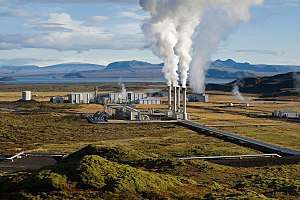Geothermal power in Russia
Geothermal energy is the second most used form of renewable energy in Russia but represents less than 1% of the total energy production. The first geothermal power plant in Russia was built at Pauzhetka, Kamchatka, in 1966, with a capacity of 5 MW. The total geothermal installed capacity in 2005 was 79 MW, with 50 MW coming from a plant at Verkhne-Mutnovsky. Russia is currently developing a 100 MW plant at Mutnovsky and a 50 MW plant in Kaliningrad.[1] Most geothermal resources are currently used for heating settlements in the North Caucasus and Kamchatka. Half of the geothermal production is used to heat homes and industrial buildings, one third is used to heat greenhouses and 13% is used for industrial processes.
Five major geothermal power plants exist in Russia.
Potential resources include the Northern Caucasus, Western Siberia, Lake Baikal, and in Kamchatka and the Kuril Islands.[2]
List of geothermal power stations
List of Geothermal power stations in Russia
| Name | Location | Field | Operator | Capacity (MW) | Annual Generation (average GWh) | Commissioned |
|---|---|---|---|---|---|---|
| Mutnovskaya Power Station | Petropavlovsk-Kamchatsky, Kamchatka Krai | RusHydro | 50 | 322.93 | 2003 | |
| Pauzhetskaya Power Station | Petropavlovsk-Kamchatsky, Kamchatka Krai | RusHydro | 14.5 | 59.5 | 1966 | |
| Verhne-Mutnovskaya Power Station | Petropavlovsk-Kamchatsky, Kamchatka Krai | RusHydro | 12 | 58.3 | 1999 | |
| Mendeleevskaya GeoPP | Kunashir Island, Kuril Islands | 1.8 | 2007 | |||
| Okeanskaya GeoPP | Iturup, Kuril Islands | 3.6 | 2007[3] | |||
See also
References
- ↑ "2007 Survey of Energy Resources" (PDF). World Energy Council 2007. 2007. Archived from the original (PDF) on 9 April 2011. Retrieved 23 January 2011.
- ↑ https://pangea.stanford.edu/ERE/db/WGC/papers/WGC/2015/01061.pdf
- ↑ https://www.geothermal-energy.org/pdf/IGAstandard/WGC/2010/0145.pdf
